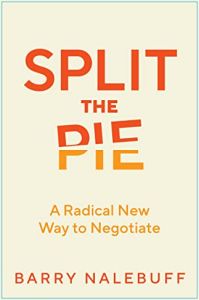Join getAbstract to access the summary!

Join getAbstract to access the summary!
Barry Nalebuff
Split the Pie
A Radical New Way to Negotiate
HarperBusiness, 2022
What's inside?
Split the pie is a groundbreaking and collaborative negotiation method that makes everyone a winner.
Recommendation
Yale Business School professor Barry Nalebuff offers an innovative new way to negotiate based on the principles of game theory. First, identify the “pie”: the value parties generate by making the deal. Then, calculate how to divide the gain created by an agreement. Nalebuff’s clever, refreshing negotiation approach isn’t simply theoretical. It’s one he used successfully when selling Honest Tea, the company he co-founded, to Coca-Cola. Splitting the pie isn’t limited to high-stakes negotiations, either. It also works in situations such as breaking a lease, buying a car, proposing a benefits package or even haggling at the flea market.
Summary
About the Author
Barry Nalebuff is the Milton Steinbach Professor at the Yale School of Management and is the co-author of several business books, including Thinking Strategically and Mission in a Bottle.

















Comment on this summary